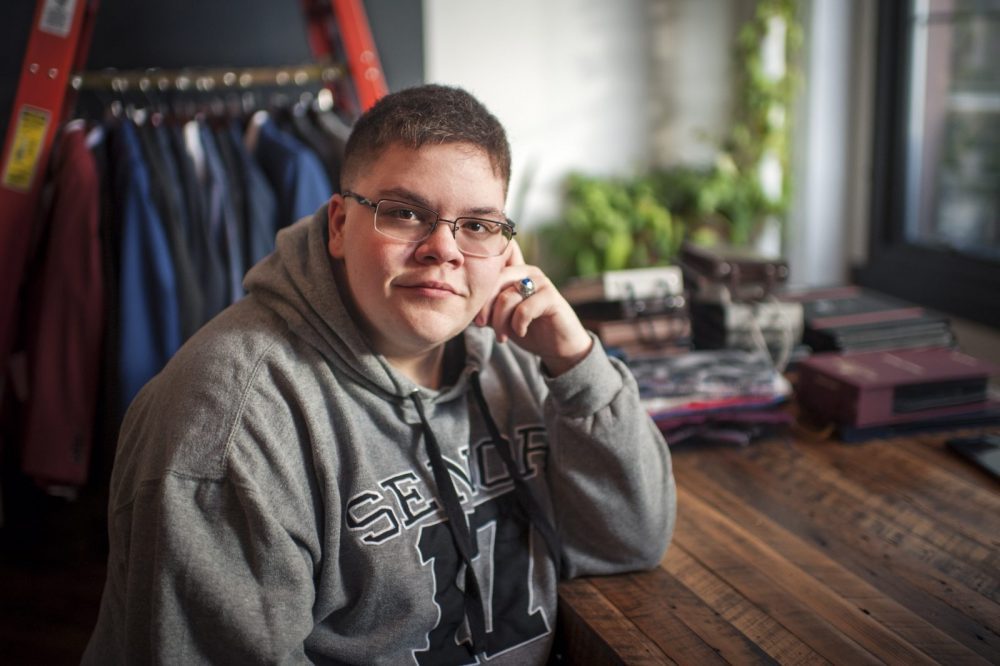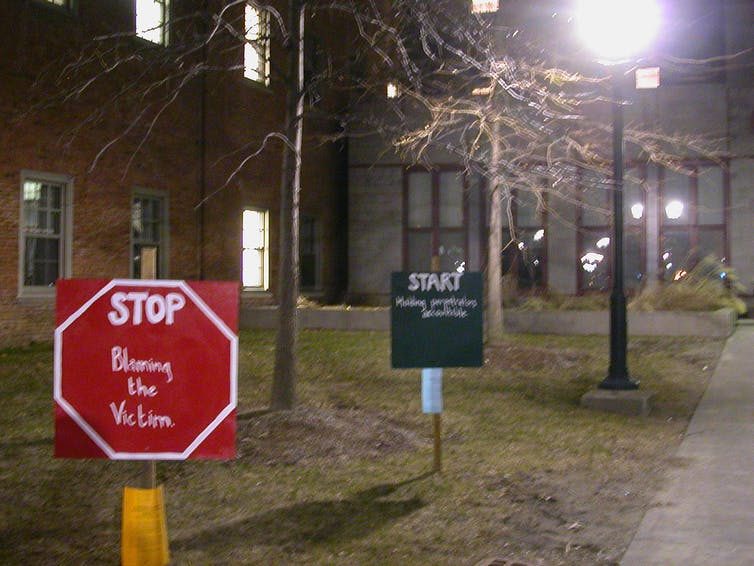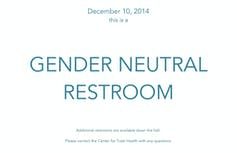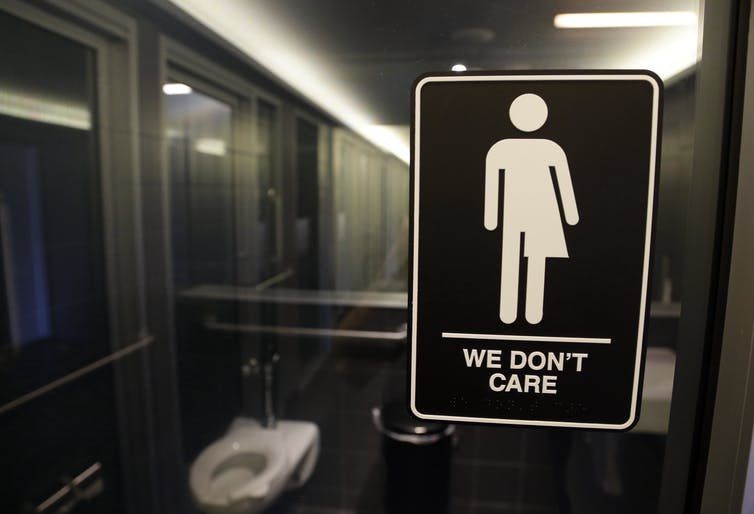Transgender students are currently suffering significant setbacks at the local, state and federal level, limiting their access to public bathrooms and threatening their health and safety.
The national spotlight has turned to transgender individuals who are finding their ability to use public bathrooms under investigation – and sometimes attack – by school boards and state legislators.
But why has transgender bathroom use garnered such attention? And how will it impact transgender students?
My research shows how political and legal battles over LGBTQ rights can negatively impact the daily lives of LGBTQ individuals and families. Right now, transgender students are currently suffering significant setbacks at the local, state and federal level, limiting their access to public bathrooms and threatening their health and safety.
Here’s why.
The current state of transgender bathroom rights
On Feb. 22, President Donald Trump rescinded a key protection issued by former President Barack Obama. Obama’s 2016 “dear colleague” letter required schools that receive federal funding to accommodate a transgender student’s gender identity when granting access to bathrooms or other gender-specified facilities.
In her explanation of Trump’s directive, Secretary of Education Betsy DeVos argued that although “protecting all students, including LGBTQ students” is “a key priority for the department,” the issue of transgender bathroom access is “best solved at the state and local levels.”
However, as the past year indicates, there are problems with leaving this critical civil rights issue up to state legislatures.
For instance, at least 10 states are considering bills that would require individuals to use multi-stall public bathrooms that match their biological gender – and at least two impose criminal sanctions on any violation.
State bills like these would take precedence over local efforts to enact anti-discrimination policies. North Carolina, for example, passed one such state law last year: the now infamous HB2 bathroom bill. The bill was introduced in direct response to a Charlotte City Council ordinance outlawing discrimination against members of the LGBTQ community.
Meanwhile, Arkansas legislators prevailed on Feb. 23 in a similar battle with local officials over transgender bathroom rights. The Arkansas Supreme Court overturned a nondiscrimination ordinance passed by the city of Fayetteville, ruling that one city cannot expand the state’s anti-discrimination protection to include gender identity.
In both of these cases, the state laws and city ordinances are in direct conflict, but the state takes precedence, making it illegal for transgender individuals to use the bathrooms matching their gender identity.

As is true in many cases involving LGBTQ rights, the Supreme Court may end up having the last word on the issue. The court was set to hear oral arguments in March for a case involving a transgender boy’s fight for adequate access to restrooms in his high school.
All told, only 13 states (and the District of Columbia) explicitly protect against gender identity discrimination in public schools. Without these statewide protections – and with local governments being overruled by state law – many transgender students living in the remaining 37 states cannot feel safe when using school bathrooms.
Issues of physical, emotional safety
So why do we need legal protection against bathroom restrictions?
The stakes are high for transgender students.
Studies show that transgender students could be harassed, sexually assaulted or subjected to other physical violence when required to use a gendered bathroom.
Recent studies suggest that over 50 percent of transgender individuals will experience sexual assault in their lifetime (a rate that is far higher than for nontransgendered individuals), and that (absent protections) using bathrooms could pose a significant threat of physical harm or harassment.
One survey, commissioned by UCLA’s Williams Institute, found that 68 percent of participants were subjected to homophobic slurs while trying to use the bathroom. Nine percent confronted physical violence.

Another study that surveyed transgender individuals in Washington, D.C. found that 70 percent were either verbally threatened, physically assaulted or prevented in some way from using the bathroom of their choice. Some experienced more than one form of such behavior.
Yet another survey found that 26 percent of transgender students in New York were denied access to their preferred bathrooms altogether.
The result? Transgender students need to constantly weigh the trade-offs as they consider bathroom options.
As one University of Washington student articulates:
Do I choose physical safety or emotional safety? Do I choose physical health or mental health?
Bathroom redesign
In response to demands from transgender advocates, parents and transgender students, administrators from California to Texas, in elementary schools and colleges, have considered the costs and benefits of redesigning bathrooms to accommodate transgender students.
For example, students at the University of Pittsburgh can now use bathrooms that conform to their own gender identity. Arizona State University, Ohio State and Wesleyan University, among several others, have instituted policies requiring all new construction to include gender-neutral bathrooms. They are assessing how to modify the existing bathrooms to become gender-neutral or single-stall facilities.

As increasing numbers of primary- and secondary-school-aged children are identifying as transgender, public schools have become “ground zero” for fights over bathroom safety.
Miraloma Elementary School, in San Francisco, for instance, removed gendered signs from many of their bathrooms.
About two years ago, Governor Jerry Brown signed into law the School Success and Opportunity Act, requiring that all students be able to access bathrooms or locker rooms that are consistent with their own gender identity in California’s K-12 settings.
Need for safety
But these school or district-level efforts have been either limited to states with existing gender identity protections (like California) or have been overturned by school board or state action.
This is why Obama’s directive was so important. Regardless of where a student lived or attended school, it provided students with legal protection.
Without the directive, and despite DeVos’ assurances, bathroom options will be limited for many transgender students.
Either they have to travel quite a distance to get to the nearest single-stall gender-neutral bathroom, or just “hold it in.”
Such options have clear drawbacks and health risks. Urinary tract infections, depression and even suicide could be among them.
One study of transgender individuals found that over 60 percent of participants who had experienced some form of bathroom exclusion had attempted suicide – a rate far higher than among respondents who had experienced no constraints on bathroom use.

Importantly, the risks of physical and verbal assault – as well as the attendant risks of depression and suicidality – are present even when a transgender student uses the bathroom that matches his or her birth-assigned gender.
When students who, in every visible way, present as their identified gender are forced to use bathrooms that match their biological genders, reactions are strong. Payton McGarry, a transgender male, describes being “screamed at, pushed, shoved or even slapped” when he used the women’s restroom after he began to develop male attributes.
This leaves transgender individuals with no real public bathroom option. As Brynne Tannehill, a transgender woman, describes, you could use “the women’s room and probably be OK and break the law.” Or “you walk into the men’s room… and you stay and that immediately marks you as transgender.” In this instance, argues Tannehill, following the law is far riskier. “Last year, we had 22 or 23 trans women murdered.”
As a result, sometimes transgender college students see their best option as renting a house near campus so they can go home to use the bathroom.
Recent transgender hotline activity suggests that Trump’s actions have provoked fear among transgendered individuals and their allies. As news spread of his new directive, hotlines were flooded with calls. For instance, in January, Trans Lifeline received on average 139 calls per day. On Feb. 23, the lifeline fielded 379 calls. The crisis hotline has also seen a marked increase in “high severity calls” – those indicating “immediate crisis” – since Trump’s inauguration.
Legal groups like the American Civil Liberties Union (ACLU) are continuing their fight in court, arguing that these bathroom bills “push ugly and fundamentally untrue stereotypes that are based on fear and ignorance.”
For many, though, Trump’s decision to prioritize states’ rights means no bathroom options for trans students – especially in states that prohibit any local accommodation.
“Trans women are killed for using the men’s restroom, and they’re jailed for using the women’s restroom,” explains Tyler Beebe, a 27-year-old trans woman. “In the end, what choice do we have?”
Alison Gash, Assistant Professor of Political Science, University of Oregon
This article is republished from The Conversation under a Creative Commons license. Read the original article.


